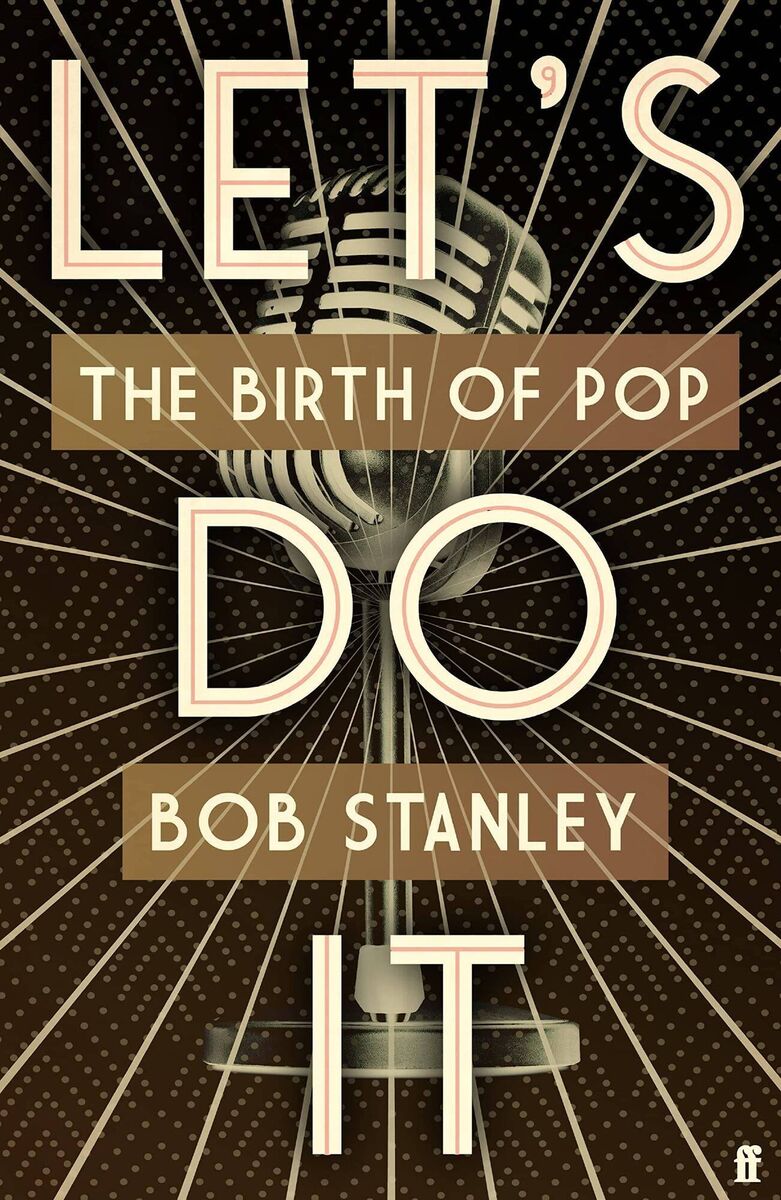Book review: Bob Stanley's Let's Do It: The Birth of Pop is an expression of music and all its colours

Bob Stanley Musician, author, journalist Book: Lets Do It Picture: Alasdair McLellan
Bob Stanley's Let’s Do It is vying for the title of best music book of the year. Here in Ireland, however, it will have to compete against This Woman’s Work: Essays on Music, edited by Sinéad Gleeson and Kim Gordon, and reviewed in this paper on May 7. Stanley is the author of the hugely successful Yeah Yeah Yeah which looked at pop music from 1950 onwards. Now, nearly a decade later, he has produced Let’s Do It as a prequel, starting at the beginning of the 20th century. Stanley wrote the book, he says, to “make sense of different times, eras and genres”.

Anyone approaching Let’s Do It will, as Stanley does, have “clots of knowledge”, maybe will even own a thorough understanding of one or more genres, but again, like the author, feel all at sea and out of their depth in the face of chronology. But first the semantics need addressing: Stanley considers pop to be the sort of music which is brought into the home on vinyl; it is played and replayed — all three minutes of it — until it becomes part of a person’s identity. The word “popular” in terms of culture is something altogether different, of course, a binary in opposition to “highbrow”, something that belongs to the masses rather than the elite.
Divisions and splits, many of which are familiar to music lovers, such as those between fans of The Beatles and followers of The Rolling Stones, or British bands against their American contemporaries, or progressive versus conservative are, in Stanley’s view, unified by time.
They are shown to be part of a continuum which benefitted from “push and pull” and “ebb and flow”. Stanley is also keen to explore the way music has been affected by oppressive attitudes such as racism and sexism. He has sought out lesser-known artists and foregrounded them so that they can take their rightful position in the halls of fame.
Stanley has spent many hours during the 10 years since Yeah Yeah Yeah delving into archives of the British Library, including those in the Eccles Centre for American Studies.
This research builds on the less-academic work undertaken during his life as a music journalist and, indeed, as a musician in Saint Etienne. The band’s most-recent release, I’ve Been Trying to Tell You, includes sampled tracks from the late 1990s and, like earlier work, aims to evoke nostalgia, or reminiscences, from specific periods in history and culture. The album is, Stanley says, like a “filtered memory — it couldn’t really be anything obscure or it wouldn’t be a shared memory”. In Let’s Do It Stanley is pursuing the same aim, only here the filters are off, and he can probe a wider canvas.
One of the things that a book like this relies on is a good index. This one is a marvel. On encountering a pile of volumes in the entrance of a bookshop readers will thumb through, searching for a particular favourite, now almost lost to knowledge in the obscurity of passing time, and find it, given its due at last. Turn to the back to look up a favourite song or musician and discover a surprisingly chunky entry, with directions to pages which elucidate.
Whilst this sort of treasure hunt is good fun, it is also rewarding to start at the beginning and read right through to the end. The route follows the development of the music; highlighting influences but also bouncing off historical events and mores.
In the second chapter, ‘Elite Syncopations: Scott Joplin and Ragtime’, Stanley suggests that this music was the “American pulse” but that it took that country “some time to find it”.
This was, Stanley thinks, because owing to its racist, segregational outlook the white-ruled States did not acknowledge black music. Ragtime came from the Mississippi Basin, the geographical heart of North America, and it was crazy fun music for dancing. The basic rhythm, strong and regular, was superimposed with syncopation, making it seem ragged.
Playing in “tenderloin” nightlife districts Scott Joplin could reach men and women, blacks and whites. In Sedalia, Missouri, Joplin’s act was heard by one John Stark who published ‘Maple Leaf Rag’. Joplin, of course, was not alive in 1973 when his 1901 composition ‘The Entertainer’ became the theme tune for the film The Sting. He has not received the acclaim he deserves partly, according to Stanley, because he yearned for “cultural quality”. His wife had him committed as insane because he thought a black man like himself could “stage grand opera”. When Joplin died he was interred
anonymously and it was only after the Newman/Redford film came out that he was he finally recognised as a genius, and a stone erected.
Stanley opens the chapter ‘Black and Tan Fantasy: Ellington and the Cotton Club’ with a quotation from Percy Grainger which opines that Duke Ellington is one of the three greatest composers that ever lived; the other two being Bach and Delius. Stanley agrees with this statement to the extent that he says that if he had to choose only one musician from the 20th century, denying all others, it would, indeed, be Ellington.
The great pianist said that “music, popular music, is the real reflector of the nation’s feelings. I am trying to play the natural feelings of a people”. This attitude, according to Stanley, helped him avoid the fate of his predecessor Scott Joplin. Ellington, according to his sister, Ruth, hid beneath “veil upon veil upon veil”; he retained a mystery about himself that, Stanley thinks, allowed him to succeed without interference. In addition, Ellington understood, says Stanley, that the music he wrote should perfectly “fit on two sides of the new 33.3 rpm vinyl format”.
In the context of Ellington’s career “Black and Tan” referred to clubs, in Harlem, where black people mingled with white. One such was the Cotton Club which, according to Stanley, was about “white privilege and the social underclasses”. The speakeasies, including the Cotton Club, flourished during Prohibition but closed in 1933 when it again became legal to have a drink.
Ellington was sometimes criticised for playing to white only audiences but he protested that when they came to his concerts they had to listen to the lyrics and melodies of his music.
The songs spoke of “black culture and history” said Ellington and who would not agree that the whites needed to hear about that. He did not forget his roots and was observed during a 1944 tour, by a journalist from the New Yorker, smoking at the train window and peering out at the fires of steel furnaces: “I think of music sometimes in terms of colour, and I like to see the flames, licking yellow in the dark, and then pulsing down to a kind of red glow”.
Moving through Let’s Do It to a later era it is great to find a chapter devoted to two women.
Here Stanley pairs them partly because of “the grimness of their pre-fame years, their dysfunctional upbringings, and because of how they were first abused by men, then used by the entertainment industry’s machinery, before being left out in the rain, dying without the final act they deserved”.
Both Judy Garland and Billie Holliday, he argues, have talent and permanence; both made singing seem easy.
Garland, for Stanley, sounds “spontaneous and free” although he hesitates to add the word “innocent” arguing that she hung onto her studied “naivety” in the face of the cruelties of her life. Some of Garland’s daily trials were made public, her “drugs, breakdowns and attempted suicides”; whilst others, like her forced abortion, kept hidden. She regarded her life as the “unkindest” possible but, argues Stanley, Holliday “could counter that with a litany of horrors”.
That story included chapters of beatings, rape, prostitution but Holliday rallied against abuse to, states Stanley, “inhabit, personalise and internalise” her songs. In London, which she loved, she haunted the Studio Club in Swallow Street off Piccadilly, drinking triple brandies with Cointreau floats. But Holliday decided to leave London and return to New York where, suffering from cirrhosis, police kept her under arrest in Harlem’s Metropolitan Hospital until she died, aged 44.
In Let’s Do It Bob Stanley gives a quintessential account of the Birth of Pop, one which will send anyone again and again to their record collection to listen to the greatest artists, well remembered or forgotten, of the 20th century.
- Let’s Do It: The Birth of Pop
- Bob Stanley
- Faber & Faber, pb €23.80





